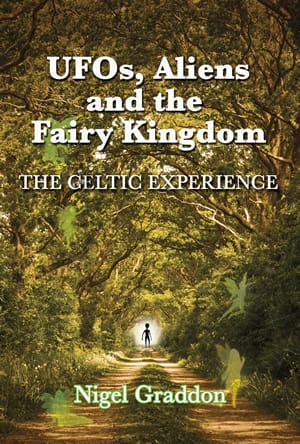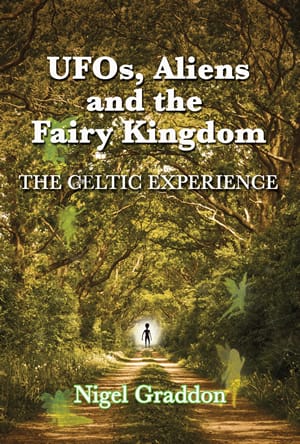Nigel Graddon explores the principal UFO and associated phenomena that have occurred in Wales and Celtic countries in the last 120 years. It is written for those who are interested in: a) Celtic history and folklore; b) increasing instances of UFO phenomena, c) evolving scientific and parapsychological research concerning the origins of such phenomena, in particular areas of research into fairy-lore and other associated mythology parallels.

The work will be published in several instalments and we hope you enjoy reading. The full text will be available to purchase as an eBook (ePUB). Please also consider supporting with a donation via Ko-fi.
Up the airy mountains,
Down the rushy glen,
We daren’t go a-hunting
For fear of little men;
Wee folk, good folk,
Trooping all together;
Green jacket, red cap,
And white owl’s feather.
Down along the rocky shore
Some make their home,
They live on crispy pancakes
Of yellow tide foam;
Some in the reeds,
Of the black mountain lake,
With frogs for their watch-dogs,
All night awake.
—The Fairies, William Allingham

Introduction
“We (that indivisible divinity that operates in us) have dreamed the world. We have dreamed it as an enduring, mysterious, visible, omnipresent in space and stable in time; but we have consented to tenuous and eternal intervals of illogicalness in its architecture that we might know it is false.”[1]
In the last 120 years Wales has hosted a surprising number of “exraterrestrial” phenomena. Most of these have been labelled as “UFOs,” certainly described as such since 1947 after American pilot Kenneth Arnold claimed he saw nine, shiny unidentified objects flying past Mount Rainier in Washington State, thereafter the term quickly becoming part of the global lexicon.
UFOs, Aliens and the Fairy Kingdom—the Celtic Experience examines equally significant inexplicable events in Wales and interprets them in the light of current scientific and cultural research, which proposes that the phenomenon of strange things seen in the skies has a parapsychological cause. This new thinking is based on certain key assumptions, namely:
Ø Unidentified Flying Objects (UFOs) are neither extraterrestrial nor the result of hoaxes or delusions, but rather are a control system, which is intended to stabilise the relationship between man’s conscious needs and the rapidly evolving complexities of living in the physical world;
Ø UFOs have both a visible reality (with mass, volume, inertia and so on) and a window to other planes of reality;
Ø UFOs’ occupants, more usually referered to as Non-Human Entities (NHEs), are creations from the dreamscape, a dimensional reality that intersects ours at right angles where we encounter UFOs in the psychic planes of perception. Writer H.P. Lovecraft described NHEs as “ultraterrestrials,” which are co-terminous with all space and coexistent with all time;
Ø UFOs neither fly nor are they objects; they materialise and dematerialise, violating in the process all known laws of motion;
Ø UFOs are not necessarily an aspect of some form of an unknowable higher order of life; they are products of a well defined and regulated technology, seemingly utterly bizarre by human standards;
Ø The same power imputed to flying saucer people of influencing human events was once the exclusive property of fairies, known in Welsh folklore as the Tylwyth Teg.
UFOs, Aliens and the Fairy Kingdom examines key events through the lens of these startling ideas, drawing upon historical, cultural, mythological and scientific data.
In their classic work about high strangeness in Wales, the fabled land of Merlin and dragons, Pugh and Holiday[2] cite the late Gordon Creighton who, writing for The Flying Saucer Review, observed that:
…beings from flying saucers are much more probably creatures who share this earth with us; regarding whom science has not a single word to say; but about whom our own written and oral traditions, in all our civilisations, speak volumes.
“Creatures who share this earth with us…”—this statement requires some thought. According to folklore the world over, humankind has been sharing the earth with supernatural beings since time immemorial. Up to the pre-industrial period our traditions referred to these beings collectively as fairy folk, recondite life forms intimately connected with the natural world.
Men and women used to live their lives much closer to nature than has been the practice over the past two hundred and fifty years, a blink of an eye compared to the length of time that humankind has been living on this planet. Consequently, unusual life forms if glimpsed or experienced in former times were readily associated with the natural world, and invariably described and stories told of them in terms of the earth’s basic elemental makeup.
Countless tales were told about the fairy folk and their supposed origins because it is in the nature of men to seek to explain and rationalise the unexplainable. Then came the Industrial Revolution, the age of the machine. Those among the strata of society that for millennia had traditionally toiled on the land moved to towns and cities to find work in the new age “dark Satanic Mills.” The minds of men and women were then inculcated with new mental archetypes: the spinning jenny replacing that of the plough, and the farm worker discarding his harvest scythe for the navvy’s spade to dig canals and railways.
The rapid switch from farm to factory inevitably generated a sense of doubt and fear and a feeling of deep loss for a bucolic past. This emotional upheaval elicited a whole host of social and political challenges. Later, C.G. Jung reflected deeply on this phenomenon. He readily understood that the fear factor caused by rapid and fundamental social change had led humankind to look to the skies for help because it could no longer be found on the green and pleasant earth with which it was innately familiar, hence the appearance of signs in the heavens. What once had been routinely described as fairy visitations took on a technological connotation and revealed themselves to percipients as flying disks or other like-symbols.
The sixteenth century villagers of Merionethshire were terrified of entering Coed-y-Dugoed Mawr (the Great Dark Wood) for fear of encountering the Red Fairies who lived in dens in the ground, had fiery red hair and long strong arms, and stole sheep and cattle by night. Such was their fear that locals kept scythes in their chimneys to repel these terrible beings.
There are countless tales in myth and folklore of fairies and little green men. Growing evidence posits the theory that there is little or no difference between them and that the intrinsic nature of these accounts and the entities described is one and the same. By removing the cultural, social and temporal factors that separate these narratives we see them for what they are: encounters with non-human entities (NHEs), although not necessarily non-human like.
It is the memes and tropes of successive epochs that seek to label these phenomena, which, in essence, are simply brushes with energy forms that exist in what Jung described as “a yet unknown substrate possessing material and at the same time psychic qualities.”[3] In UFOs, Aliens and the Fairy Kingdom we will examine in depth the possible nature of Jung’s substrate and, in so doing, reach for insights into the vexed question. Whence they come?
The following pages will seek to demonstrate that humans label little green men in accordance with their time, truth, tradition, beliefs and societal mores. One man’s goblin is another’s grey. No matter how we have described them in human history, one tantalising question remains. Do NHEs really originate in a distant galaxy? Based on current thinking, is it not more likely that they have always been among us, are among us now, and in the corner of one’s eye may be glimpsed by the flickering light of a candlestick, if Jack be nimble, Jack be quick?
What lies behind the cracks in our world remains a mystery but for those that have a hunger to know, all is not lost. Myth, legend, fairy tales, sci-fi stories and, for example, the fertile minds of Mark Frost and David Lynch, each tell us something about the “Man from Another Place”; while cutting edge thinkers in quantum physics are beginning to reveal how the existence of Twin Peaks’ parallel universe might even be possible.
In the field of traditional folklore our journey in UFOs, Aliens and the Fairy Kingdom will be guided by the work and insights of outstanding cultural figures, such as Robert Kirk and Walter Evans-Wentz, in our quest to understand the nature and origins of NHEs. Regarding modern-day UFO studies, a review of the pioneering work of researchers of the calibre of Linda Moulton Howe, John Keel, Jacques Vallée, Anthony Roberts, Geoff Gilbertson, John Michell, Carl Jung and the like will further help one arrive at a deeper understanding of a great and enduring mystery.
This work will also draw inspiration from an in-depth examination of the latest ideas from the science community on the nature of physical existence and the case for the existence of multiple dimensions. This analysis will be greatly enhanced by incorporating the key principles identified by the late Professor David Bohm in his mindblowing reflections on what precisely is reality. Can it truly be the case that man’s collective conscious is the engine of creation that makes and maintains the physical universe, moment by moment?
Do NHEs constitute a threat to humankind? Do they perceive our military and environmentally destructive actions as an existential threat to the structural integrity of the earth and to its invisible, but no less real, interconnecting and complementary worlds and their inhabitants? Do the worst among them regard the overall chaotic outpourings of our emotional selves as a vampiric Smörgåsbord of delights, food for the Dark Gods who relish a gift that just keeps on giving? Conversely, in the midst of global chaos, do we also detect in our encounters with anomalous forces the building of a new energy, one founded on the qualities of hope, grace, inspiration, positive belief, and love for nature?
Increasingly, particularly in the U.S., the term UFO (Unidentified Flying Object) is being replaced by UAP (Unidentified Anomalous Phenomena). The first recorded use was in the U.S.A.’s Office of the Director of National Intelligence’s June 2021 report titled “Preliminary Assessment: Unidentified Aerial Phenomena,” with the acronym's label evolving from “aerial” to “anomalous” later.
Since the early 1950s the term UFO has referred to flying objects that are not identifiable through conventional means. Usually, these objects are speculated to be “flying saucers” or extraterrestrial aircraft. More recently, American military and scientific experts charged by the National Intelligence office to investigate the phenomenon have wanted a way to divert sightings from stereotypical associations with UFOs and alien activity. Authorities take the view that separating the human from the nonhuman is important as government officials, scientists and other professionals that work with UAPs aim to take a more realistic and timelier look at what exactly these strange sightings are all about.
In my opinion these considerations are all well and good, but one can become a little too sniffy about attributing this or that label. I am happy to continue using the term UFO on the basis that if it looks like a duck and quacks like a duck, then a mysterious flying object, whether it be from space, fairyland or Jung’s “unknown substrate,” is what it is irrespective of how we choose to dress it up.
In its provision of excellent case studies for our investigations, Wales punches well above its weight in comparison with countries of far greater landmass or population. Anomalous events such as those that will be described clearly indicate that the history of unexplained phenomena in Wales is characterised by large-scale activity of astounding breadth and significance.
One thirty-fourth the size of Texas, for example, and with a population of a little over 3.1 million, Wales is a Celtic land filled with beauty, magic and mystery. Its legendary fare is epic. In the White Book of Rhydderch, the Red Book of Hergest and the Hanes Taliesin, the three volumes that make up the Mabinogion, the earliest prose stories of Britain, we read marvellous tales of enchantment. Spellbound, we are gripped by Arthur’s fantastical exploits in which the Once and Future King quells mountaintop monsters and troublesome dragons. In the pages of “Llud and Llefelys” we read of fairies, the bad ones of the bunch that want to seize and do harm to humans. Wales’ ancient power exists today in its haunting hills and valleys. Stories persist about the presence of dimensional portals in the Black Mountains area of the Brecon Beacons in the southeast and in Pembrokeshire’s Preseli hills in the southwest. The western regions of Wales are favourite haunts of the Tylwyth Teg. Legends speak of them living on Pembrokeshire’s enchanted islands, in underground dwellings in Cardiganshire, and under lakes in Carmarthenshire close to the hillside cave where Merlin sleeps with his fairy consort, Vivian.
There is a tradition that Shakespeare visited Brecon for background material for A Midsummer Night’s Dream. The story goes that Shakespeare’s friend, Robert Price, took the playwright to Cwm Pwca, the haunt of the ellyllon in the Clydach Gorge and the purported glen setting on which the work is based. The fairies are reputed to inhabit a cave in the wooded gorge. Today, the gorge and cave are popularly known as the Valley of the Goblins and Shakespeare’s Cave.
Part 1 of UFOs, Aliens and the Fairy Kingdom focuses on key anomalous events that have taken place in Wales since the beginning of the 20th century. Part 2 examines myth, folklore, expert opinion, and current thinking in the physical sciences regarding the nature of UFOs, their occupants and origins. Are they truly visitors from the cosmos or, remarkably, are they homegrown?
[1] Borges, J.L., Other Inquisitions, 1937-1952, University of Texas Press, 1964.
[2] Pugh, R.J., and Holiday F.W., The Dyfed Enigma, Faber and Faber, London and Boston, 1979.
[3] Jung, C.G., Flying Saucers: A Modern Myth of Things Seen in the Skies, ARK edition, London, 1977
Acknowledgements by Author
I thank Caz Clarke for the opportunity to cover the 2016 Pentyrch incident, “one of the biggest cases in the UK, and possibly the world,” Linda Moulton Howe for her gracious permission to quote from her groundbreaking studies, David Childress for his cover art and his unstinting support and encouragement over the past 20 years, Andras Beno for his enchanting photo of the garden ghost, Peter Boyce for his photo of yours truly, and, not least, Chris Jones and his colleagues at Cambria Publishing for the opportunity to disseminate the contents of this new work.



